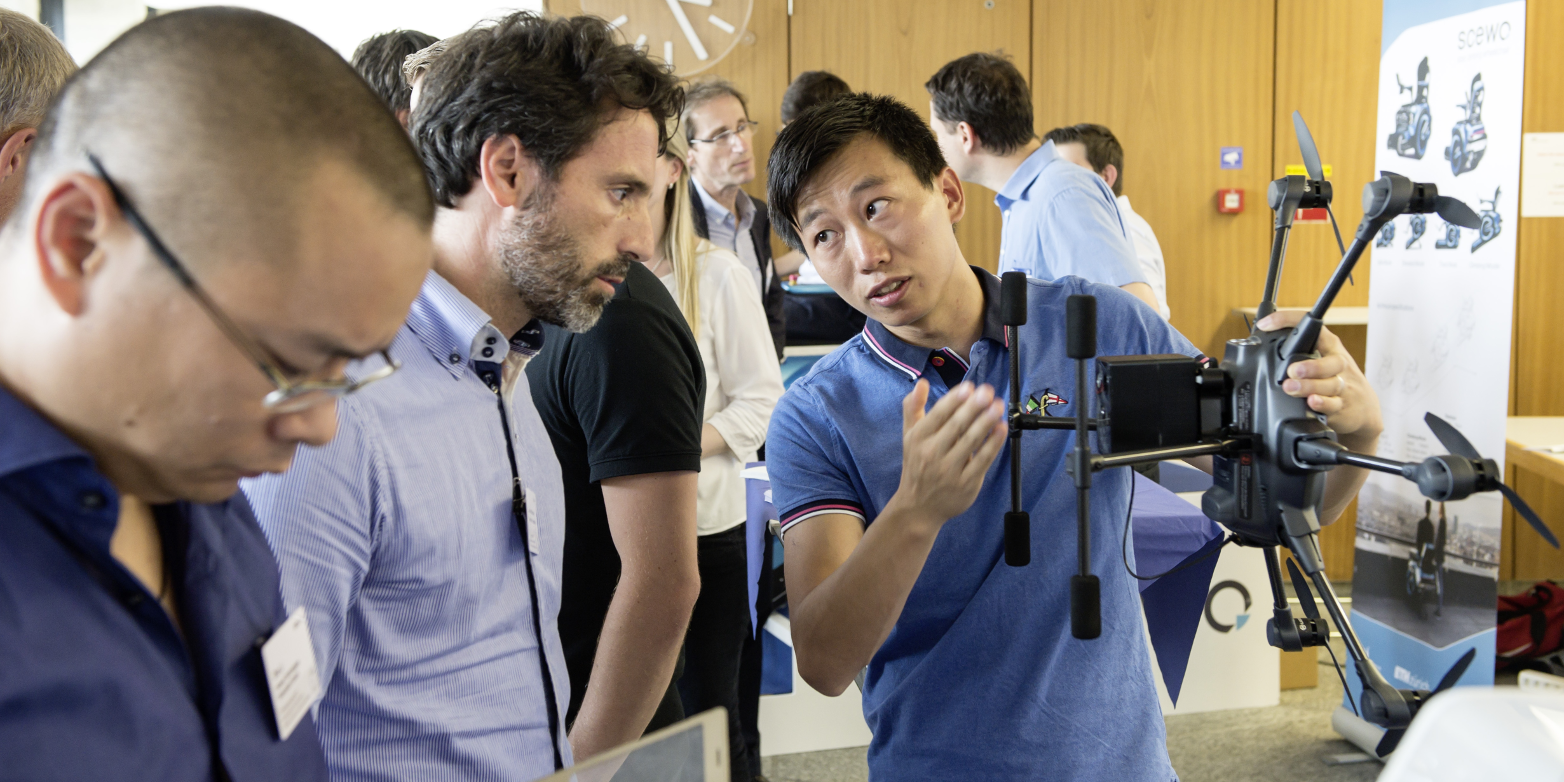A good match for innovation
Small and medium-sized enterprises (SMEs) play a vital role in the Swiss economy. Read on to see hwo SMEs and ETH Zurich create marketable innovations based on successful partnerships.

When people hear the name ETH Zurich they might think of their own degree course, a brilliant young person studying there, or simply its reputation for world-class fundamental research. But what about its commitment to university-industry collaboration? “ETH has lots of industry partners, but there’s still far too little awareness of the excellent research projects it runs with SMEs,” says Detlef Günther, Vice President for Research and Corporate Relations.
Open door for SMEs
One of the primary tasks of publicly funded universities is to channel the knowledge they gain from fundamental research into industry and society. The opportunities offered by new technologies and techniques – such as additive manufacturing – are what companies need to maintain their competitive edge and create jobs. “In Switzerland, 99 percent of companies are SMEs with fewer than 250 employees, so ETH is obviously keen to collaborate with small and medium-sized enterprises, too,” says Günther. The problem, he says, is how to boost awareness of this fact in our collective consciousness.
The best opportunities for collaboration arise from situations where you can link new knowledge from fundamental research with a concrete application.”Urs Zuber, Head Industry Relations
Some three years have passed since ETH expanded its Industry Relations team as a gateway for industry. Today, it offers a website specifically aimed at SMEs featuring examples of how ETH collaborates with industry. Günther argues that these efforts are finally starting to bear fruit: “We’re now seeing far more SMEs finding their way to ETH.” Approximately a quarter of the enquiries received by Industry Relations come from SMEs, and projects involving SMEs now make up one third of the contracts signed between companies and the technology transfer office ETH transfer. “ETH has made real progress in this area over the past few years,” says Günther.
The Industry Relations gateway
ETH Industry Relations fielded more than 300 enquiries last year alone. “We help them find the right people to talk to and set up meetings. But we also tell the companies how ETH works, what frameworks are available for collaborative projects, and how much those projects typically tend to cost,” says team leader Urs Zuber. In the latter stages of this process, the team evaluates possible cooperation partners at ETH, organises laboratory visits for company representatives, and runs workshops in which professors present their field of research and the company explains what they’re looking for. “The best opportunities for collaboration arise from situations where you can link new knowledge from fundamental research with a concrete application,” says Zuber. If an enquiry can be handled using conventional technologies and methods, the team refers the company to someone who can help. “But we do our best to assist them here, too,” he adds.
Inspire: knowledge for the MEM industry

The transfer of knowledge from fundamental research is particularly valued in the mechanical engineering sector. To encourage this practice, ETH Zurich and the Swiss mechanical and electrical engineering (MEM) industries joined forces 14 years ago to create inspire AG Inspire AG, a competence centre that aims to boost the innovative capabilities of Swiss industry. “We want to plug the gap between fundamental research at universities and product development in industry,” says Martin Stöckli, COO of inspire. Much of its focus is on SMEs, many of which do not have their own R&D department.
Inspire has a total of 80 researchers working in ten research groups, which are supervised by six ETH professors. They cover all fields of knowledge that are relevant to the design, development and industrial manufacturing of high quality technical products. Typically, there are around 70 projects running at any one time, often involving multiple companies and universities.
Stöckli cites the example of a collaborative project that set itself the goal of using ultrashort laser pulse machining to produce carbide micro tools, in this case micro milling cutters with a diameter of less than half a millimetre. The project partner FRAISA SA, which is headquartered in Bellach in the canton of Solothurn, produces these and other micro tools for companies that make medical and elec- tronic devices, as well as for watchmaking companies. The equipment used to produce these milling tools includes high-precision machine tools from the second partner in this project, EWAG AG, a company that supplies a wide range of industries worldwide.
Micro milling cutters are made from a very hard ma terial which – in conventional manufacturing – is typically ground using diamond tools. “The problem is that this process also degrades the diamond tool, so it’s an expensive method to use,” says Stöckli. The forces, vibrations and heat generated in this mechanical process can also damage the tool. But switching to an ultrashort pulsed laser to machine the material changes the situation entirely: “In simple terms, the high-energy laser beam blasts away whatever atoms it hits without affecting the adjacent material, so you get virtually no heat input in the workpiece itself,” says Stöckli, explaining how the process works.
The beam essentially vaporises the material – but it does so with a truly remarkable degree of precision. The researchers involved in the collaborative project successfully demonstrated that the tool blank suffers no damage at all as long as a suitable beam source is used. What’s more, initial trials of the laser-machined micro milling cutters suggest their performance is at least equivalent to that of tools produced using grinding – plus they are far cheaper to make.
The project was supported by the Swiss Innovation Agency Innosuisse (formerly CTI, see article on page 18), which includes inspire in its list of accredited research institutes. But how does a collaborative project like this come about in the first place?
“We see lots of ideas emerging at trade events, expert meetings organised by Swissmem, and events such as the ETH Industry Day, where ETH professors and group leaders from inspire get together with company representatives,” Stöckli explains. Training courses also tend to be a good springboard for future collaboration. But it can take time for the initial contact to morph into a fully-fledged project. “That transitional period can actually be a good thing because it’s important to build up trust in the abilities of the partner you’ll be working with,” says Stöckli.
Direct contact
Mirko Meboldt is a Professor of Product Development and Engineering Design at ETH Zurich and one of the six lead professors at inspire – but he also makes direct contact with companies. One example stemmed from a radio interview he gave in his capacity as an additive manufacturing expert three years ago. The interview prompted a call from Thomas Weber – and that proved to be the start of a successful collaboration. Weber is the owner of ALPA, a high-end camera manufacturer with 12 employees located at the foot of the Zürichberg. The company produces system cameras for professional photographers that are compatible with numerous different lenses and backs.
“We began by carrying out a pilot study as part of a semester project to familiarise ourselves with the technology,” says Meboldt. They focused on how additive manufacturing would affect the design and production processes, and how readily the customer would accept the new technology. The next stage involved building up incremental knowledge at ALPA over a two-year period. To begin with, the partners printed small components such as a lever for adjusting camera settings. “That wasn’t too challenging,” says Meboldt with a smile. Nevertheless, it was an important first step in the overall implementation strategy: “Building up experience with small-scale projects is a crucial part of helping staff take ownership of the technology,” says Meboldt. This approach allows partner companies to build up expertise in using the technology, minimising the risk of financial losses.

Next came a textbook example of additive manufacturing in the form of a lens hood. Previously, ALPA had made its hoods out of hard plastic or metal in a range of sizes tailored to the various lenses. They were heavy, and tended to jolt the lens when knocked. After chatting to various partners, the team came up with the idea of printing this component from a kind of rubber material known as thermoplastic polyurethane. Each lens hood can be optimally designed for a specific combination of focal length and sensor format. This calls for a wide variety of shapes, which traditional manufacturing techniques could never have coped with. “You’re basically eliminating the design and logistics costs, so it’s cheaper for ALPA to produce the component. And of course customers benefit more from this design because it’s lighter and they can fold it up and put it in their pocket,” says Meboldt.
The partners already have a configurator planned for the future that will allow customers to personalise the design of the lens hood. The goal is to create a seamless digital chain from the customer to the production line.
At this point, the partners in the additive manufacturing project decided the time had come to tackle a complete system, in this case a camera for photogrammetry that allows users to make high-resolution 3D scans that show the texture of objects. Some two years into the project, ALPA announced that they consider additive manufacturing to be a forward-looking technology of major significance for the company. That was the green light for submitting an application to CTI, now known as Innosuisse.
Under the project name PLATON, the partners are now hoping to forge a basis for products in the video sector with the greatest possible level of customisation and short innovation cycles. PLATON is based on the idea that the steady convergence of photography and moving images – particularly online – is opening up entirely new market segments in which customers’ needs are still relatively opaque. 3D printing offers a quick and flexible way to respond to these needs with new products.
“That’s a good example of the roadmap we try to follow for the companies we work with,” says Meboldt. One of the main reasons he likes working with SMEs is that they typically have lean decision-making processes which make it easier to get products to market faster – something he regards as a central element of his work: “I firmly believe that our research only benefits society if people actually buy the products,” says Meboldt. And that’s why he hopes to find many more companies who are open to innovation.
Globe - KMU & ETH
Small and medium-sized enterprises (SMEs) play a vital role in the Swiss economy. Read the current issue of Globe to see how SMEs and ETH Zurich create marketable innovations based on succesful partnerships.
